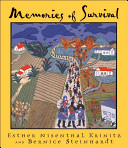
A story of surviving the Holocaust in Poland, illustrated in a collection of embroidered panels, and told in the survivor’s own words. The author, a survivor of the Holocaust, illustrates her experiences through fabric panels that capture her and her sister’s childhood as they, disguised as Catholic farmhands, are separated from their family and escape Nazi rule.
Featured in Volume I, Issue 2 of WOW Review.
- ISBN: 9780786851263
- Published: 2005 , Hyperion Book CH
- Themes: Holocaust, Survival
- Descriptors: Europe, Intermediate (ages 9-14), Nonfiction, Picture Book, Poland, Primary (ages 6-9)
- No. of pages: 64

“Memories of Survival” by Esther Nisenthal Krinitz and Bernice Steinhardt was a personal narrative of a family’s life during World War II. This time in history particularly interests me because my grandparents were part of the US Army and US Marines during this time period. Also, as a high school teacher, I find this time period to be talked about the most across subject areas. With motifs such as fairness, tolerance, hate, family, and survival, this book can be used across the curriculum. I have spent some time in my ESL class, English class, and World History class talking about the Holocaust and other events that occurred during this time.
While reading this book, many other books came to mind that I have read; Night by Elie Wiesel, Number the Stars by Lois Lowry, The Diary of Anne Frank by Anne Frank, and Devil’s Arithmetic by Jane Yolen. All of the above books talk about this time period in different ways. Some give a storyline that is fictional, while others are personal experiences being told first hand. This book is interesting because it has two different perspectives, that of the creator of the weavings and that of her daughter, adding information to what her mother had written. Seeing the intricate weavings instead of drawings gives a personal touch to the book that creates a feeling of interest and surprise in the reader.
Having read a variety of literature based on World War II, I am curious about other stories of survival from the Holocaust. Also, how can other events of genocide occur all over the world, when there is proof that these events occurred and the debilitation that it caused? That is a questions that always comes up when talking about the Holocaust, it isn’t an isolated event that only happened once in history, and why must history repeat itself?
You can see through the images and writings that the mother had a very difficult childhood, but felt that telling her story was important and worth telling. She didn’t hide her story; she turned it into something that others could learn from. Also, she made sure that her daughter knew her story, so that she knew where she came from. It is obvious that these events traumatized the writer for her entire life, but that she was able to survive and if she could survive, others can survive when faced with life changing and difficult experiences.
I could see this story continuing with the daughter including how important these stories were while she was growing up. It is obvious that her mother’s stories meant a lot to her, and it would be interesting to hear how it changed her, hearing about her mother’s experiences. We are who we are because of our experiences and that which we are exposed to.
I would recommend using this book as a preview in a World History class, before talking about the Holocaust. Also, it can be used to show another perspective from books like The Diary of Anne Frank and Night. Exposure is very important for student, students can learn through seeing how people express themselves differently or how an event such as the Holocaust is not a single event, but an event that affected many in different ways.